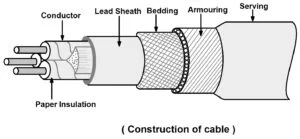An underground cable essentially consist of one or more conductors (Core) cover with suitable insulation and surrounded by a protecting cover. Underground cable employ for transmission of electric power for short or moderate distances. The general construction of three phase conductor cable or underground cable consist of following layers.

Cores or conductor
A cable may contain one or more conductors, depending on the type of service cores or conductor. Which is make of tinned copper or aluminum and it is usually stranded conductor. To provide flexibility to the cable. In the above picture you can see three conductor cable, it is use for three phase service.
See also this what is alternator in electrical?
Insulation
Suitable thickness of insulation is provided to each core or conductor. Which is usually made of applied paper, varnished cambric or rubber mineral compound. Depending on the voltage there is a thickness of the layer that the cable can withstand.
Metallic sheath
A metallic sheath of lead or aluminum is provided over the insulation, So that the cable can be protected from moisture, gases or other harmful liquids acid and alkalies of the soil.
Bedding
A fibrous material such as jute or hessian tape is apply over the metallic sheath with a layer is know as bedding. The purpose of bedding is to protect the metallic sheath from corrosion or mechanical injury due to armouring.
See also this What is resistance ? in electrical
Armouring
Armouring is provided over the bedding consists of at least one or two layers of galvanized steel wire or steel tap. It is use to protect the cable from mechanical injury during laying during operation.
Serving
To protect armouring from atmospheric condition, a layer of fibrous material similar to bedding is provided above the armouring know as serving.
Classification of electrical cables
Cables for underground service can be classified in two ways by (1) The type of insulating material use in their construction (2) The voltage for which they are manufactured.
The latter method of classification is generally prefer, according to which cables are divide into the following groups.
- Low tension (L.T.) cables — up to 1000 volt
- High tension (H.T.) cables — up to 11,000 volt
- Super tension (S.T.) cables — from 22 kV to 33 kV
- Extra high tension (E.H.T.) — from 33 kV to 66 kV
- Extra super voltage cables — beyond 132 kV
So there may be one or more cores in a cable depending on the type of service, It can be single core, two core, three core and four core. For three phase service, depending on the operating voltage and load demand, either three single core cable or three core cable may be use.
Short question answer
Question -1 Give two principal disadvantages of underground cables
Ans – There are two major disadvantages of underground cables (1) Capital costs are very high for underground cabals. Depending on the system voltage, it may be 4 to 8 times that of the bare conductor overhead line. (2) It is true that the occurrence of fault in underground cabal is very rare. But once it does, it is difficult to detect and repair is expensive.
Question – 2 What are low tension (L.T.) cables ?
Ans – Cables up to 1100 volt are know as low tension cables. So these are almost always PVC cables and find many applications in domestic, commercial and industrial circuits.
Question – 3 What are the factors that govern the selection of LT power cables?
Ans – It is important to consider the following factors while choosing the right size and type of cable (1) System voltage (2) Current carrying capacity (3) Mechanical strength required (4) Short circuit rating and (5) Economy.
Question – 4 What are high tension cables ?
Ans – Cables use for voltages above 1100 volt are know as high tension cables. So the factors that govern the selection of HT cables are the same as those LT cables.
We can transmit or distribute the electric power through underground cable. and underground cable have many advantages such as low maintenance cost, less chance of fault, smaller voltage drop and better general appearance.
However, installation costs are high and insulation problems are introduced at higher voltages than equivalent overhead system. For this reason underground cables are employ where overhead lines are impractical to use.
So from the above discussion we learned about the construction of underground cables and Classification of electrical cables. Hope you enjoy this article, Thank you.
